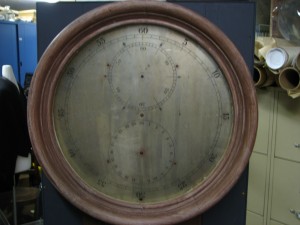From the Collection: Polsey Clock

This piece is a bit of a mystery. It comes down to us simply as the “Polsey Clock.” Our other clocks come from famous makers, but Polsey is virtually unknown. It’s also very plain, somewhat battered, and missing a few pieces. Still, in its way, it’s the most interesting clock we have. It may be the lone surviving remnant from an ambitious project created by Moses Farmer.
Here’s where I get to put on my miSci cap. Moses Gerrish Farmer was one of the countless electrical inventors that appeared during the nineteenth century, before the giant corporations like GE and Westinghouse formed and sucked up all the oxygen. Farmer, from New Hampshire, is one of the most important of these inventors, and some of his contributions were long lasting.
For example, in 1856 Farmer demonstrated a duplex telegraph between New York and Philadelphia, sending two signals down the same wire. In 1872, Thomas Edison took his technique, combined it with some other ideas, and created the duplex and quadruplex telegraphy system, sending two signals down the wire and two signals back. He sold the idea to Western Union, one of his first major sales.
(Being Thomas Edison, he then also sold it to Jay Gould’s Atlantic and Pacific company. This is probably the incident that caused the editors of the New York Tribune to dub him the “great professor of duplicity and quadruplicity,” one of the more colorful insults that Edison ever received.)
But before all that, Farmer was working on a fire alarm system in Boston that would work much like systems we use today; there would be a central alarm with signal boxes scattered throughout the city, all connected by telegraph cable. In 1855, he ran into the director of Dudley, Benjamin Gould, who must have liked the idea of a central system that could communicate through telegraph. But rather than fire, Gould was thinking clocks.

So in 1855, Moses Farmer, along with an assistant named John Polsey, came to the Dudley Observatory to create a clock system. The clock was set into a niche near the entrance to the observatory, and it was wired to other clocks throughout the building through telegraph cable. This allowed the main clock to send signals to the other clocks that would keep them all synchronized. And the telegraph cable also ran out of the building, allowing the clock to send accurate time to distant places.
That last part was part of Gould’s plan to sell accurate time to buildings throughout the capital and down to New York City. It was an ambitious plan, which would have meant telegraph cables running to the government buildings and railroad depots along the Hudson, all reaching back to Dudley Observatory to keep every clock running accurately.
The system was finished in 1856, just in time for the inauguration. It became a centerpiece of Gould’s inauguration speech:
The clock for mean time has been made by our accomplished fellow-citizen, Mr. Farmer, of Boston. Its pendulum has no weights, and needs no winding. […]On the right is the great marble dial, three feet square, which shows the Observatory time, beat by the beautiful electro-magnetic pendulum which is swinging on the left, and which is not only to supply this city with its time correct to the fraction of a second, but is to flash it along the electric wire till its little tick be heard upon the lakes and at the ocean, and in all the rail-road stations lying between — the stay of the navigator, the guardian of the traveler, the safeguard of human life, and the promoter of human welfare on land and sea.
It never worked out the way Gould wanted it to. His successor, George Washington Hough, did send accurate time to the state capitol, but it never became the large scale (and lucrative) operation that Gould wanted.
Farmer’s clock system disappears from the record soon after the inauguration. When the original observatory building was vacated, the system was dismantled. This portion of the system, most likely one of the secondary clocks in the system, was set up in the central dome with the Pruyn telescope. It appears to be the only portion that now survives.
